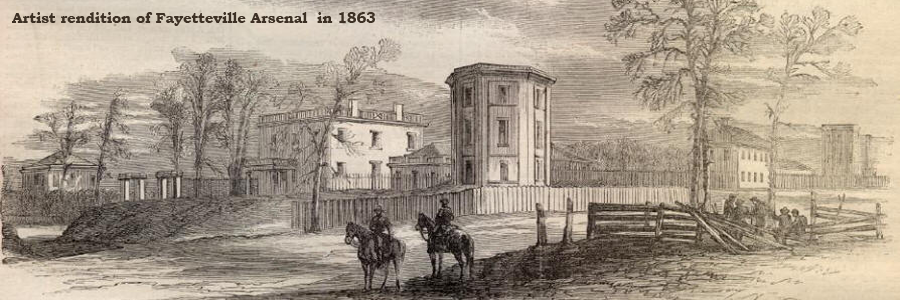
Museum of Cape Fear Historical Complex
810 Arsenal Avenue, Fayetteville, NC 28305
Phone: (910) 486-1330
Hours: Tuesday-Saturday 10:00 a.m. to 5:00 p.m.
Sunday, 1:00 to 5:00 p.m.
Closed Mondays and major holidays

Confederate Army
LT Colonel Frederick Childs
Fayetteville Arsenal Commander
Strength: 250 - 500
Fayettville Arsenal - March 10-14, 1865
In 1865, as Union General William T. Sherman was leading his forces on the Carolinas Campaign it had become apparent to the Confederate commander, LT Colonel Frederick Childs, that Fayetteville was the next major target. When Sherman reached Columbia, South Carolina, LTC Childs ordered the construction of earthworks for the defense of the Fayetteville area. Remnants of these earthworks can be seen on the grounds of the Veterans Administration Hospital on Ramsey Street. After Columbia, Sherman divided his army into two wings with the ring wing under General Solcum, which moved to the arsenal at Fayetteville. Before Sherman's arrival, the commanding officer of the arsenal removed most of the weapons and machinery from the facility. He hid them in Chatham County coal mines so that they would not fall into Union hands. Confederates under General William J. Hardee evacuated Fayetteville as Sherman approached. Hardee withdrew on March 10 and relocated to the Smithville Plantation on the Fayetteville - Raleigh Stage Road just south of the town of Averasboro.
Significance
The Fayetteville Arsenal had been the property of the United States Army from 1838 until it was seized in the spring of 1861 by local residents supportive of Southern secession. The state initially used the newly acquired arsenal to manufacture infantry ammunition and accoutrements, and to repair small arms. With the transfer of captured machinery from the Federal arsenal at Harpers Ferry, the Fayetteville Arsenal began producing rifles. The arsenal's capacity grew throughout the war, and by 1865, it consisted of several foundries, machine shops and other facilities necessary to sustain the Confederate war effort. The production of arms and ammunition continued off and on until January 1865, the Arsenal was then fully manned and operational, but, the combination of shortages of raw materials and Fayetteville's isolation from any of the state's key rail lines limited the arsenal's productivity.


The Fayetteville Arsenal and Its Destruction
Resistance was given by the Confederate forces, but the battered and weary were quickly overwhelmed by the tremendous numbers and firepower of the invaders. Sherman entered Fayetteville on March 11, 1865 and took possession of the Arsenal (which had been stripped of its arms, munitions, and useful machinery by the retreating Confederates). The Harpers Ferry rifle manufacturing machinery was said to have been hidden in the Egypt in Chatham County coal mines. Sherman made his headquarters at the arsenal and stayed in Fayetteville from March 11 until the 14th. He was afraid the people of Fayetteville would begin using the arsenal to manufacture more weapons and ammunition after he left. So, on March 12, 1865, Sherman ordered the destruction of the arsenal. As the fire raged, some remaining artillery shells exploded which helped completed the devastation of the arsenal. Buildings throughout the city shook from the explosions, and many nearby homes caught fire from the intense heat as the arsenal burned. The Union army also destroyed shops, factories, food suppliers, fields, railroad property, gristmills, and newspapers in the two days. The arsenal site stood in ruins until 1873.
Today, base remanents of the buildings and symbolic metal fixture of one of the towers of the arsenal can be seen in the memorial park behind the Cape Fear Historical Complex.
